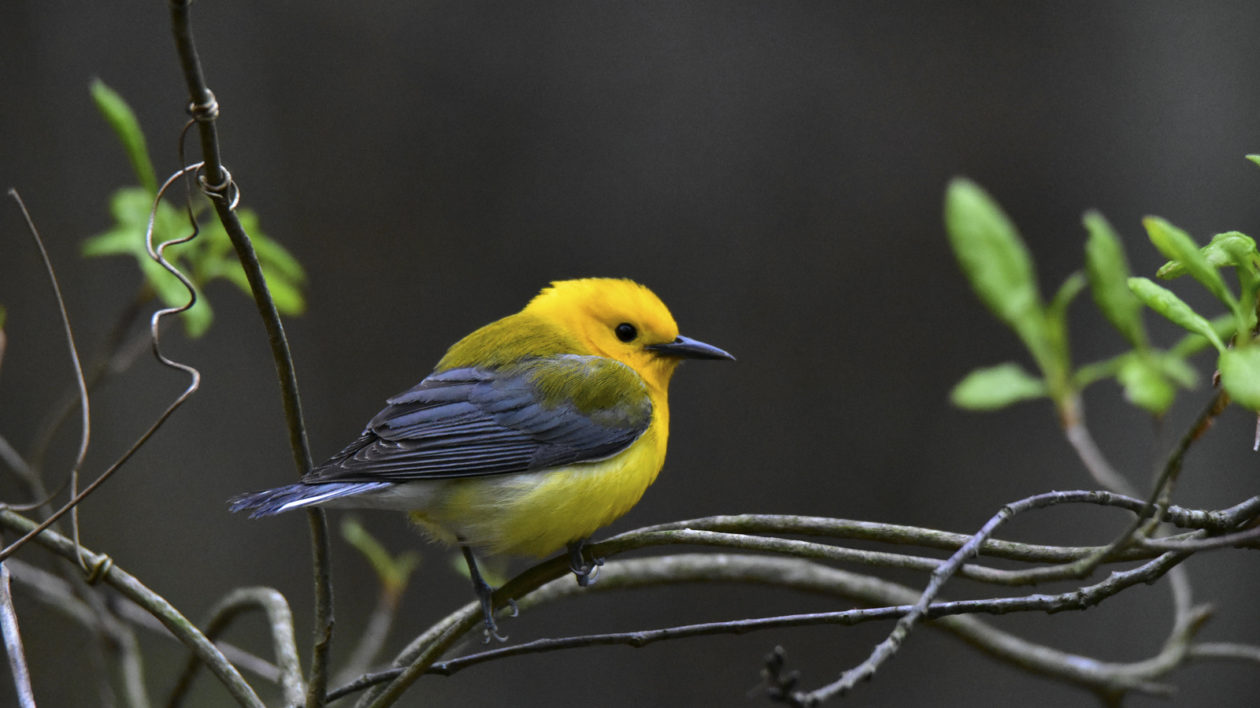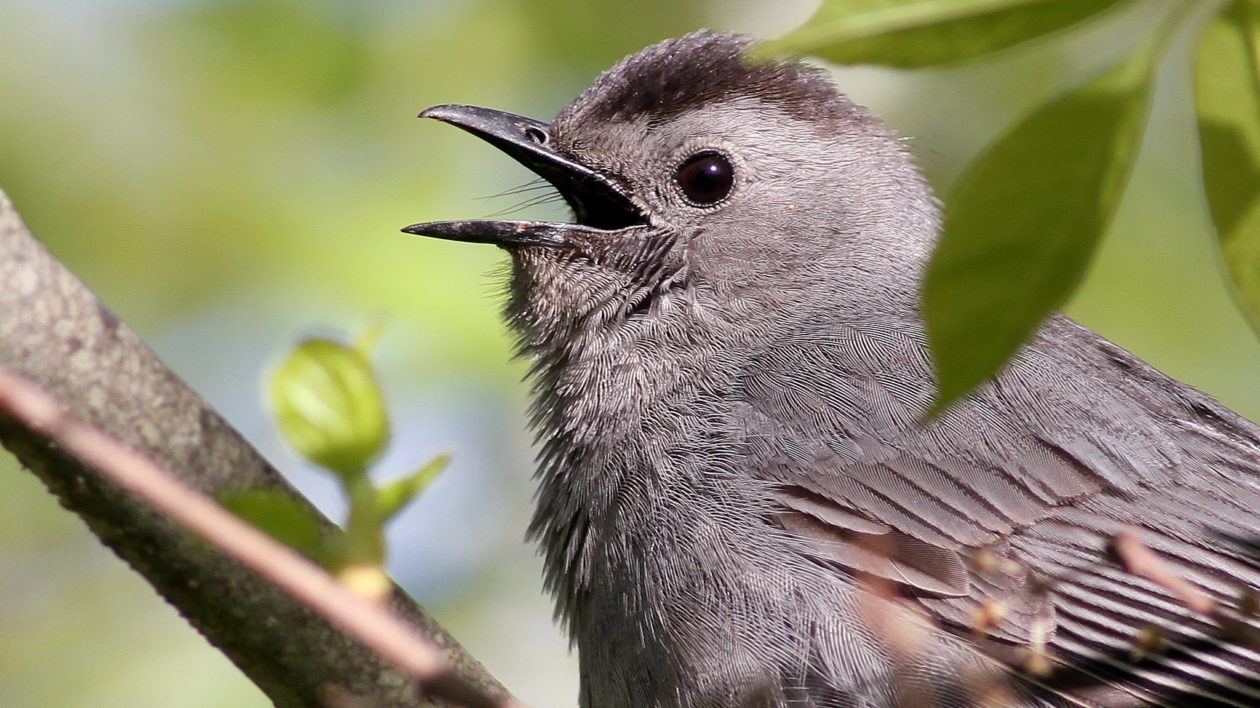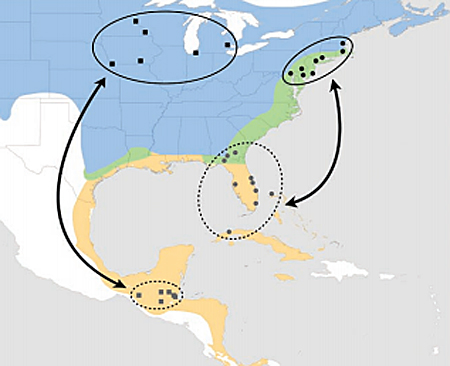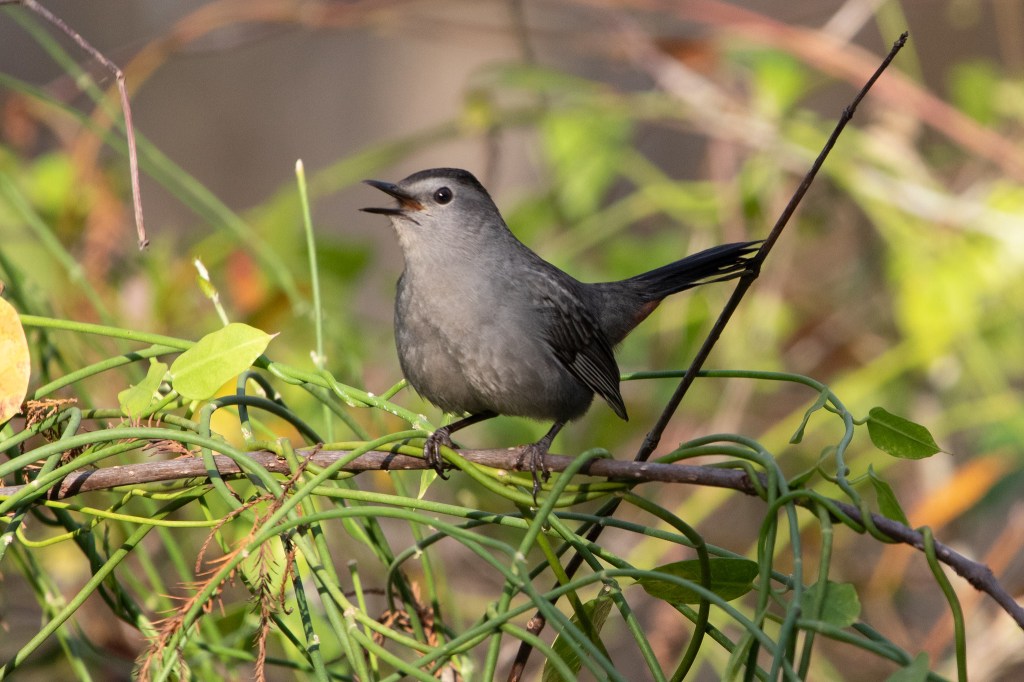Consider the gray catbird: the tropical long-distance migrant that may well be nesting in your backyard this summer.
Gray catbirds are common, so you may not pay them much attention. But look into the research, and you’ll find that this backyard bird is full of surprises. Let’s take a closer look.
As I write this, a gray catbird is singing in my backyard.
It arrived here in New Jersey several weeks ago and may already be building a nest with its mate somewhere in the neighborhood.
I am wondering where my catbird spent its winter – and whether this is the very same catbird that was in my yard last summer. Research on catbirds can help answer these questions.
Every spring, dozens of species of migrant songbirds make their way north from the tropics to settle into nesting habitats across North America. Indeed, half of all North American birds spend their winters south of the U.S. border – from Mexico through South America.
Most of these species are habitat specialists and we might see them in our backyards only briefly during migration as they make their way to more remote places.

The gray catbird, on the other hand, is a migrant from the tropics that is quite happy to claim a breeding territory in a wide variety of shrubby habitats, including suburban backyards.
The catbird singing in your backyard this spring is likely the same one that was there last year. Individual catbirds (and numerous other species) return to the same habitat patch to nest year after year, as long as they are fortunate enough to survive from one season to the next. Studies have shown a roughly 60 percent annual survival rate for catbirds.
If your backyard catbird has a lucky streak, you could see the same bird coming back for many seasons. The longevity record for a catbird is 17 years, 11 months.
This nearly 18-year-old bird was caught and banded as a young of the year in Maryland and miraculously encountered again by banders those many years later in New Jersey.
Banding can confirm the age of birds and also confirm that the bird in your backyard this year is the same one that was there last year.
Participants in programs like Neighborhood Nestwatch can observe their backyard catbirds wearing unique combinations of colored leg bands. These identify each bird as an individual and can be viewed with binoculars. For this project, researchers and participants alike can make observations on the identity and longevity of their catbirds.
Catbirds nest in 46 of the lower 48 United States and across southern Canada. They spend the winter across an equally broad area. A proportion stay in the U.S., where they primarily occupy the Gulf Coast and Florida. Some hearty individuals hang in there as far north as New Jersey.

Others go further south to the tropics – to the forests of Mexico, the Caribbean and Central America. There, they share the woods with jaguar, tapir, fer-de-lance and toucans.
Catbirds return to the same site on the wintering grounds every year as well. Your backyard catbird might spend the winter in the shadow of Mayan ruins in Guatemala or perhaps in the Florida Everglades.

We can make an educated guess on where your backyard catbirds spend the winter thanks to a recent analysis of banding records along with the use of tracking devices.
What this work tells us is that if a catbird breeds in the upper Midwest, it is more likely to be spending the winter in Central America. If it nests in the mid-Atlantic and New England, your catbird is likely spending the winter in Florida or the Caribbean.
As more studies like this one are carried out, we will have a further refined picture of “migratory connectivity” between nesting and winter sites. And we will be able to make even better guesses about where our backyard catbird might be next winter.
“A Few Raisins Give Him the Greatest Delight”
If you want to kick things up a notch for your backyard catbirds this summer, in addition to providing water, you can also offer them fruit.
As the poet Mary Oliver observes in her poem “Catbird”: “But a few raisins give him the greatest delight.”
One of the pleasures of a birding holiday in the tropics is watching birds at fruit feeders. After hours of seeking difficult-to-see skulking birds of the undergrowth and fast-flitting birds of the high tree tops, birding respite can be found at lodges and cafes that maintain fruit feeders for birds. Dozens of species of brightly colored birds come into easy view to eat banana, papaya and citrus at close range.
Catbirds bring a bit of this culture back with them from the tropics and are among the few birds at our northern latitudes that will readily eat soaked raisins, sliced orange and even grape jelly.
Back to my well-fed catbird. Is he the same bird as last year? Without banding him, I can’t know for sure. But I do know that he will do everything within his power to return here.

And return from where?
Maybe it is time to combine science with imagination. The science tells me that he wintered somewhere in Florida or the Caribbean.
But for better spatial resolution, my imagination is saying the Zapata Swamp of Cuba. Listen to what he sounds like there (in the audio file) … and then listen for the catbird in your yard!




I’ve have a few pairs of catbirds this year inNewHampshire ! I feed them grape jelly and half oranges that I put onto small branches . They love and I love to hear them. I will try raisins next Spring.
My friend, Three Feathers, the catbird.
Earlier this summer, I went up to my art room to paint and saw three loose tail feathers on the carpet that our cat Iggy was pawing at. With much trepidation, I searched the room looking for a mutilated bird, but my heart leapt I looked up at the ceiling fan and saw the creature perched up there safe, sound and scared — the look on his face was priceless. I covered him in a towel and released him outside thinking he would just plop to the ground, but he flew over the house. He was happy as was I.
The rest of the summer was awesome. Every time I went outside, Three Feathers, as I named him, flew down low and close and “talked” with me. I could just tell he knew me and was thankful that I saved his life. He would appear on low hanging , sit on a branch inside our lilac bushes, on a fence, standing in the grassy shade of an apple tree in our acknyard. I would call his name, go “mew, mew, mew” or “kitty, kitty, kitty” and he would show up minutes later, mere feet from me.
People think I might be nuts, be we have parrots and we know how intelligent avians are. There is no doubt in my mind that we had a visceral connection. He and his family brought a lot of and fun to our summer, but I haven’t seen him lately, so maybe they left for Mexico. I am encouraged by your blog that they might be back next year.
I have the sweetest little gray catbird living very close to the house this year, for the first time…I’ve always had them ‘up the hill’, away from the house. He/she’s so cute, so friendly! as friendly as the house wrens! Always flitting close by when I’m working in the many gardens. Here’s my questions: is it true that they steal the nests of other birds? And is it true that they mimic the sounds/songs of other birds?
Catbirds were devouring my apple cores until around June 1st. I put out a fresh on 2X daily. Any reason for this? Have they moved on, did mommy bird like them while nesting?
Thank you!
Lor
We discovered a gray catbird nesting in a shrub about 2 feet from the house and 5 feet off the ground. There were three baby birds in the nest, mother sitting on them. We would observe the mother feeding them and the papa nearby. The chicks were always hungry. We could easily look down at the birds in the nest from our bedroom window. It seemed as though they were still very young and dependent on being fed, did not look very mature at all. We last saw the birds about 9:30 in the morning. At 2:30 p.m. the nest was empty! I was disappointed as I was curious as to when/how they would leave the nest. How young can the birds fly away—does the female somehow push them out?
We also live in South Jersey as the author of this site does.
Thank you for the information . We have a very friendly catbird family here this year which may be the same 2 as last year with a year old young one maybe tagging along still? The three come to me for fruit , only a few inches away and fed from a spoon!Maybe someone in Florida has been feeding it over the winter.
We have two catbirds in our yard. One of them flies to our windows and picks against them from early morning to early evening. He/she also eats nuts and berries off the bird feeder but most of the time it picks against the window.
Thanks for the article, we have a pair of catbirds that return every year. Our yard is mostly surround by bushes and small evergreen trees which allows them follow me around the yard like a little gray shadows and sometimes sqawk if I’m not paying attention to the moth they just caught. My husband I always comment that the catbirds are spying on us again. I will have to put some fruit out for them as a treat I did not know they were a tropical bird.
Listening to the cat-bird’s call, I realize that I have heard this bird my whole life! I was confusing the call with that of a blue jay. The cat-bird is somewhat “squeakier” than the jay, and not so rancorous. Lived in Florida most of my life, now in Western North Carolina. I will be paying more attention to who visits my feeders now. Thank you!
A male Gray Catbird came to my feeder in early November. It is still here today, Jan 6th 2019. It appears to eat seeds, pecks at the suet block (maybe for the embedded seeds?) & checks my open compost pile. Now that I have read your info, I will add some fruit. Graham Edwards Lions Head Ont Can. ( Right on the 49th Parallel)
Though I find the calls of the catbird less than melodic, I have no animus toward this creature; however, as they devour all of my black raspberries and blueberries, I have decided to do my best to discourage them from hanging around.
I have seen them here in Ct,
They come and eat suet and drink water, they seem to be a bit shy?!!!
Oh, regarding my just posted comment, I’m in Eastern, PA. Allentown.
Thank you for this article. I have always loved catbirds. Though I do love the color grey, it was not the color of the catbird that attracted me, but their curious and gregarious nature in the yard. This year was finally the first time they nested in my city yard with shrubs and trees getting larger. I was fascinated by their stealth almost warrior like constant vigilance in the whole process. They were experts at diverting my attention away from just where they were nesting, even though I knew it had to be right under my nose, which it was. The babies came out and hung out in the yard shrubbery for a day or two and then were gone. I was disappointed that they did not start a second brood in the same nest and they all seem to have moved on now (it’s early July). Do they build a new nest elsewhere for a second brood?
I work on a golf course in Massachusetts, and we are blessed with many beautiful, fearless, inquisitive and very chatty Gray Catbirds on the grounds. I know where they nest (mostly in thorny, dense bushes and shrubs) and if any fellow workers try to trim back those bushes, I tell them no way! The birds and their nesting habitat come first. It’s nice to see so many comments from people who both love and appreciate the presence of these birds as much as I do. I am going to look into a fruit feeder, because we have them here in our back yard, too. The more catbirds, the merrier!
P.S. I also saw a beautiful male Eastern Bluebird at the golf course a few weeks ago as well. Such a beautiful -and rare – sight here in most of eastern Massachusetts.